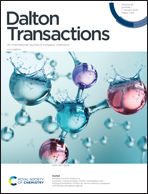Aggregation induced emission of a new naphthyridine-ethynyl–gold(i) complex as a potential tool for sensing guanosine nucleotides in aqueous media†
Abstract
A new organometallic alkynyl–gold(I) complex capable of exhibiting aggregation induced emission was designed and synthesized. The linear complex structure possesses a central Au(I) atom, bearing two axial ligands: (1) 1,3,5-triaza-7-phosphaadamantane and (2) 2-acetamido-7-ethynyl-1,8-naphthyridine. While the former accounts for its partial solubility in an aqueous environment, the latter acts as a receptor unit for binding guanosine nucleotides and derivatives via multiple hydrogen bonding interactions. At high concentrations, aggregation of the complex was observed by the formation of new absorption (λmax ∼ 400 nm) and emission bands (550–700 nm). Formation of aggregates of ca. 60 nm diameter was confirmed by Small Angle X-ray Scattering (SAXS). Disruption of the aggregates in the presence of guanosine derivatives resulted in a ratiometric signal with apparent association constants in the order of 105 M−1 and high sensitivity (around 63% signal change) which are, to the best of our knowledge, in line with the highest values recorded for nucleotide sensors based on hydrogen bonding and capable of working in water. Computational studies indicate the presence of additional hydrogen bonding interactions that account for the strong binding of the Au(I) complex to phosphorylated guanosine nucleotides.

- This article is part of the themed collections: Spotlight Collection: Aggregation induced luminescence of metal complexes and 20th Anniversary of Aggregation-Induced Emission


 Please wait while we load your content...
Please wait while we load your content...